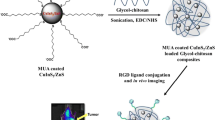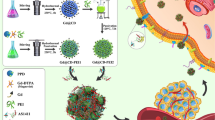Abstract
In the experiments, high-quality, water-soluble and near-infrared (NIR)-emitting CdSeTe and CdSeTe/CdS quantum dots (QDs) were successfully prepared. The average size of CdSeTe⁄CdS QDs was 7.68 nm and CdSeTe QDs was 4.33 nm. Arginine-glycine-aspartic-serine acid (RGDS) peptides were linked to CdSeTe/CdS QDs by N-(3-(dimethylamino)propyl)-N′-ehtylcarbodiimide hydrochloride (EDC) and N′-hydroxysuccinimide (NHS). The prepared RGDS-tagged NIR CdSeTe/CdS QDs (denoted as RGDS-CdSeTe/CdS) had an average diameter of 24.83 nm and were used for cancer cell immunofluorescence imaging. The characteristics of RGDS-conjugated CdSeTe/CdS such as morphology, structure, spectra, stability, cytotoxicity, and near-infrared microscopic imaging were investigated in detail. HepG2 cells were incubated with the novel fluorescent probe (RGDS-CdSeTe/CdS), which realized immunofluorescence targeting and imaging. The results reported here open up new perspectives for integrin-targeted near-infrared imaging and may aid in tumor detection including imaging-guided surgery.















Similar content being viewed by others
References
Asjitate Y, Kim SH, Tanaka E (2012) Two-wavelength near-infrared fluorescence for the quantitation of drug antiplatelet effects in large animal model systems. J Vasc Surg 56:171–180
Bailey RE, Strausburg JB, Nie SJ (2004) A new class of far-red and near–infrared biological labels based on alloyed semiconductor quantum dots. J Nanosci Nanotechnol 4:569–574
Ben-Lulu M, Mocatta D, Bonn M (2008) On the absence of detectable carrier multiplication in a transient absorption study of InAs/CdSe/ZnSe core/shell1/shell2 quantum dots. Nano Lett 8:1207–1211
Bi W, Li XX (2012) Novel TEMPO-PEG-RGDS conjugates remediate tissue damage induced by acute limb ischemial reperfusion. J Med Chem 55:4501–4502
Carion O, Mahler B, Pons T (2007) Synthesis, encapsulation, purification and coupling of single quantum dots in phospholipid micelles for their use in cellular and in vivo imaging. Nat Protoc 2(10):2383–2390
Chan WCW, Nie S (1998) Quantum dot bioconjugates for ultrasensitive nonisotopic detection. Science 281:2016–2018
Chen HY, Cui SS, Tu ZZ (2011) Characterization of CdHgTe/CdS QDs for near infrared fluorescence imaging of spinal column in a mouse model. Photochem Photobiol 87:72–81
Cui XT, Lv YY, Liu Y (2014) Aqueous synthesis of near-infrared CdTe quantum dots for biothiols detection in biological fluids. Acta Chim Sin 72(1):75–82
Delong SA, Gobin AS (2005) Covalent immobilization of RGDs on hydrogel surfaces to direct cell alignment and migration. J Control Release 109:139–148
Ding H (2013) Luminescent carbon quantum dots and their application in cell imaging. New J Chem 37(8):2515–2520
Erogbogbo F, Yong KT, Roy I (2011) In vivo targeted cancer imaging, sentinel lymph node mapping and multi-channel imaging with biocompatible silicon nanocrystals. ACS Nano 5:413–423
Esteve FA, Abad A (2013) Applications of quantum dots as probes in immunosensing of small-sized analytes. Biosens Bioelectron 41:12–29
Freeman R, Willner I (2012) Optical molecular sensing with semiconductor quantum dots (QDs). Chem Soc Rev 41:4067–4085
Gao JH, Chen K, Xie J, Yan Y (2015) In vivo tumor-targeted fluorescence imaging using near-infrared non-cadmium quantum dots. Bioconjug Chem 21:604–609
Gao X, Cui Y, Levenson RM, Chung LW, Nie S (2004) In vivo cancer targeting and imaging with semiconductor quantum dots. Nat Biotechnol 22:969–976
Geho D, Lahar N, Gurnani P (2005) Pegylated, steptavidin-conjugated quantum dots are effective detection elements for reverse-phase protein microarrays. Bioconjug Chem 16:559–566
Guarnieri D, Capua AD (2010) Covalently immobilized RGD gradient on PEG hydrogel scaffold influences cell migration parameters. Acta Biomater 6:2532–2539
Gurusinghe NP, Hewa-Kasakarage NN, Zamkov M (2008) Composition-tunable properties of CdSxTe1-x alloy nanocrystals. J Phys Chem C 112:12795–12800
Hong H, Shi J, Yang Y (2011) Cancer-targeted optical imaging with fluorescent zinc oxide nanowires. Nano Lett 11:3744–3750
Jo DY, Yang H (2015) Spectral broadening of Cu-In-Zn-S quantum dots converters for high color rendering white lighting device. J Lumin 166:227–232
Jo JH, Kim JH, Lee SH (2015) Photostability enhancement of InP/ZnS quantum dots enabled by In2O3 overcoating. J Alloy Compd 647:6–13
Jiang W, Singhal A, Zheng JN (2006) Optimizing the synthesis of red- to near-IR-emitting CdS-capped CdTexSe1-x alloyed quantum dots for biomedical imaging. Chem Mater 18:4845–4854
Jou Amily F-j LCH (2015) Diagnosing the miR-141 prostate cancer biomarker using nucleic acid-functionalized CdSe/ZnS QDs and telomerase. Chem Sci 6:659–665
Kandiel Tarek A, Anjum Dalaver H, Philippe S (2015) Electronic structure and photocatalytic activity of wurtzite CuGaS nanocrystals and their Zn substitution. J Mater Chem A 3(16):8896–8904
Klohs J, Wunder A, Licha K (2008) Near-infrared fluorescent probes for imaging vascular pathophysiology. Basic Res Cardiol 103:144–151
Lan GY, Wei Y (2010) Synthesis and characterization of ZnxHg1-xSeyS1-y quantum dots. J Nanospart Res 12:1377–1388
Liang GX, Li LL, Liu HY (2010) Fabrication of near-infrared-emitting CdSeTe/ZnS core/shell quantum dots and their electrogenerated chemiluminescence. Chem Commun 46:2974–2976
Michalet X (2005) Quantum dots for live cells, in vivo imaging, and diagnostics. Science 307:538–544
Moulick A, Blazkova I (2015) Application of CdTe/ZnSe quantum dots in in vivo imaging of chicken tissue and embryo. Photochem Photobiol 91:417–423
Patel D, Vandromme SE (2012) Synergistic activity of αvβ3 integrins and the elastin binding protein enhance cell-matrix interactions on bioactive hydrogel surfaces. Biomacromolecules 13:1420–1428
Peng L, Wang Y, Dong Q, Wang Z (2010) Passivated ZnSe nanocrystals prepared by hydrothermal methods and their optical properties. Nano-Micro Lett 2:190–196
Regulacio MD, Han M (2010) Composition-tunable alloyed semiconductor nanocrystals. Acc Chem Res 43:621–630
Rogach AL, Franzl T, Klar TA (2007) Aqueous synthesis of thiol-capped CdTe nanocrystals: state-of-the-art. J Phys Chem C 111:14628–14637
Radmilovic V, Gasteiger HA, Ross PN (1995) Structure and chemical composition of a supported Pt-Ru electrocatalyst for methanol oxidation. J Catal 154:98–106
Sahoo PK, Janissen R, Monteiro MP (2016) Nanowire arrays as cell force sensors to investigate adhesion enhanced holdfast of single cell bacteria and biofilm stability. Nano Lett 16:4656–4664
Samanta A, Deng ZT, Liu Y (2012) Aqueous synthesis of glutathione-capped CdTe/CdS/ZnS and CdTe/CdSe/ZnS Core/Shell/Shell Nanocrystal Heterostructures. Langmuir 28: 8205–8215
Schaller RD, Sykora M, Jeong S, Klimov VI (2006) High-efficiency carrier multiplication and ultrafast charge separation in semiconductor nanocrystals studied via time-resolved photoluminescence. J Phys Chem B 110:25332–25338
Shi XB, Zheng S, Gao WL (2014) Excitation wavelength and intensity dependence of photospectral blue shift in single CdSe/ZnS quantum dots. J Nanopart Res 16:2741
Smith AM, Mohs AM, Nie S (2009) Tuning the optical and electronic properties of colloidal nanocrystals by lattice strain. Nat Nanotechnol 4:56–63
Song CX, Zhong YL, Jiang XX (2015) Peptide-conjugated fluorescent silicon nanoparticles enabling simultaneous tracking and specific destruction of cancer cells. Anal Chem 87:6718–6723
Tasy JM, Pflughoefft M, Bentolila LA (2004) Hybrid approach to the synthesis of highly luminescent CdTe/ZnS and CdHgTe/ZnS nanocrystals. J Am Chem Soc 126:1926–1927
Tian JN, Liu RJ, Zhao YC, Xu Q, Zhao SL (2009) Controllable synthesis and cell-imaging studies on CdTe quantum dots together capped by glutathione and thioglycolic acid. J Colloid Interf S 336:405–509
Wu J, Wang ZM, Dorogan VG, Li S, Mazur YI, Salamo JG (2011) Near infrared broadband emission of In0.35Ga0.65As quantum dots on high index GaAs surfaces. Nanoscale 3:1485–1488
Weissleder R, Ntziachristos V (2003) Shedding light onto live molecular targets. Nat Med 9(1):123–128
Xie RG, Kolb U, Li JX (2005) Synthesis and characterization of highly luminescent CdSe-Core CdS/Zn0.5Cd0.5S/ZnS multishell nanocrystals. J Am Chem Soc 127:7480–7488
Zayats M, Willner I (2008) Photoelectrochemical and optical applications of semiconductor quantum dots for bioanalysis. Adv Biochem Engin/Biotechnol 109:255–283
Zhang CL, Yan J, Liu C (2014) One-pot synthesis of DNA-CdTe: Zn2+ nanocrystals using Na2TeO3 as the Te source. Appl Mater Interfaces 6:3189–3194
Zheng Y, Gao S, Ying JY (2007) Synthesis and cell-imaging applications of glutathione-capped CdTe quantum dots. Adv Mater 19:376–380
Zeltvogel F, Schmid G, Hao L (2016) Scatter J: an imageJ plugin for the evaluation of analytical microscopy datasets. J Microsc 261(2):148–156
Acknowledgements
This work is supported by the National Natural Science Foundation of China (No. 20975072). We thank the Instrumental Analysis Center of Sichuan University for helping with characterization. We also thank Prof. Bin He and Prof. Xixun Yu for providing HepG2 cells and L929 cells.
Author information
Authors and Affiliations
Corresponding author
Additional information
Zhenzhen Li and Qiyi Zhang are co-first authors
Electronic supplementary material
ESM 1
(DOCX 1554 kb)
Rights and permissions
About this article
Cite this article
Li, Z., Zhang, Q., Huang, H. et al. RGDS-conjugated CdSeTe/CdS quantum dots as near-infrared fluorescent probe: preparation, characterization and bioapplication. J Nanopart Res 18, 373 (2016). https://doi.org/10.1007/s11051-016-3669-6
Received:
Accepted:
Published:
DOI: https://doi.org/10.1007/s11051-016-3669-6




